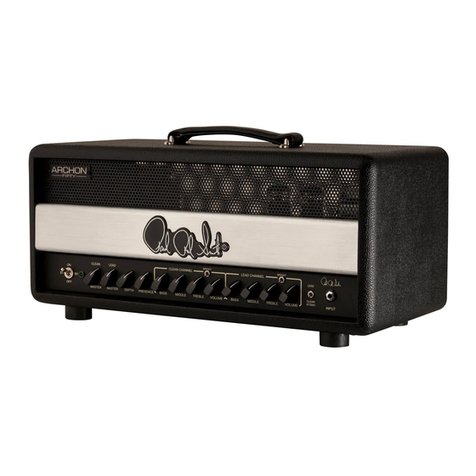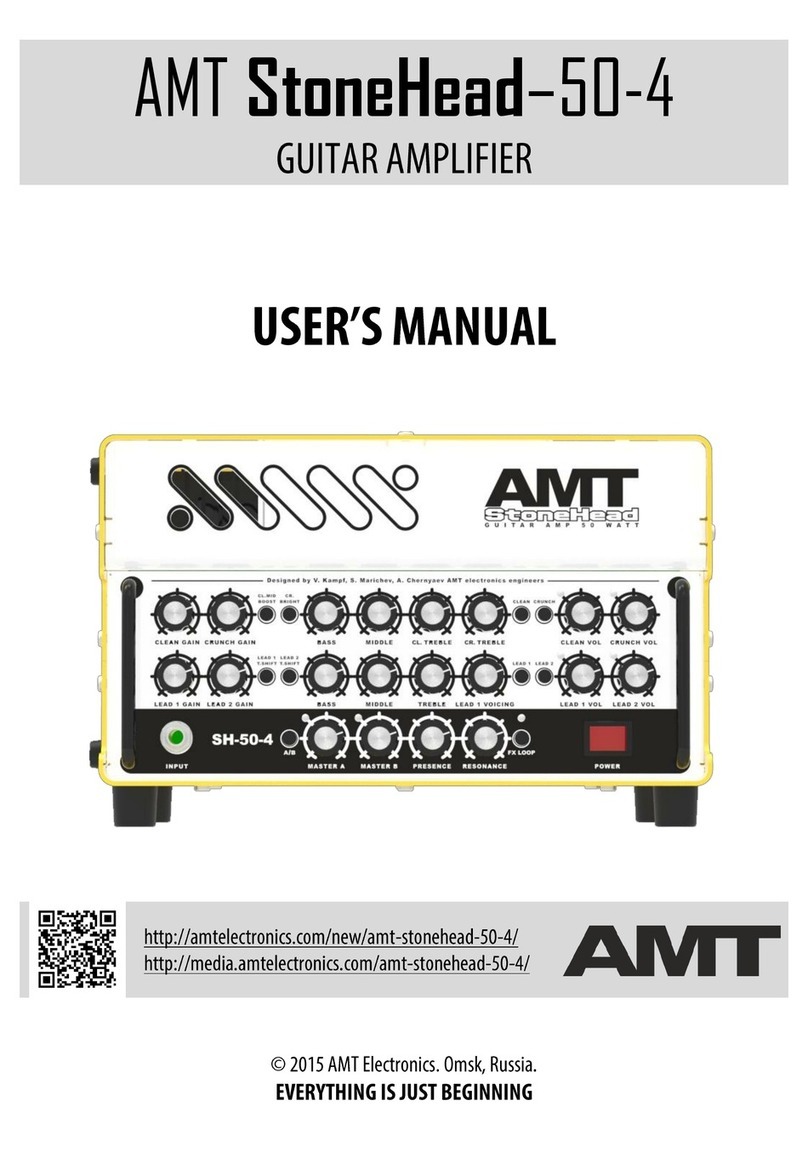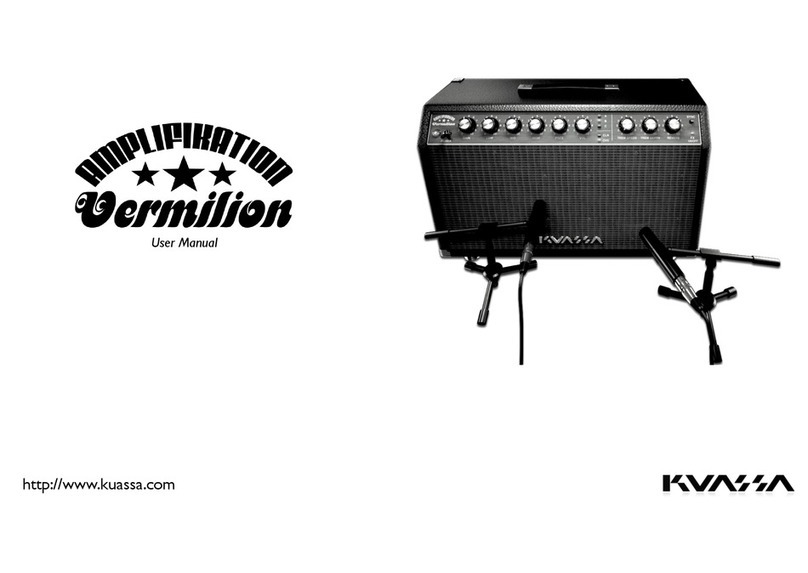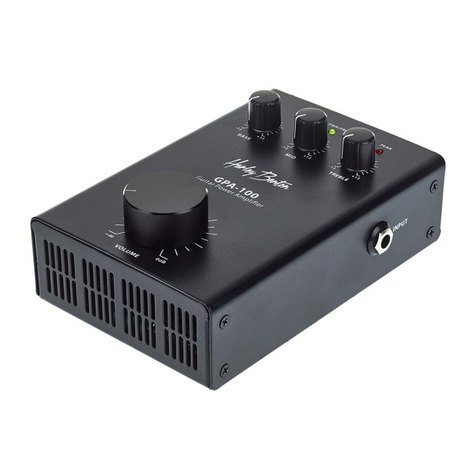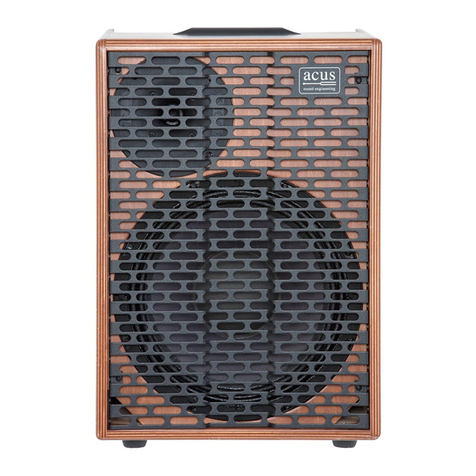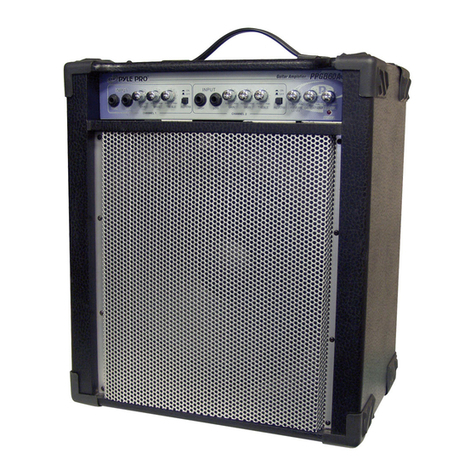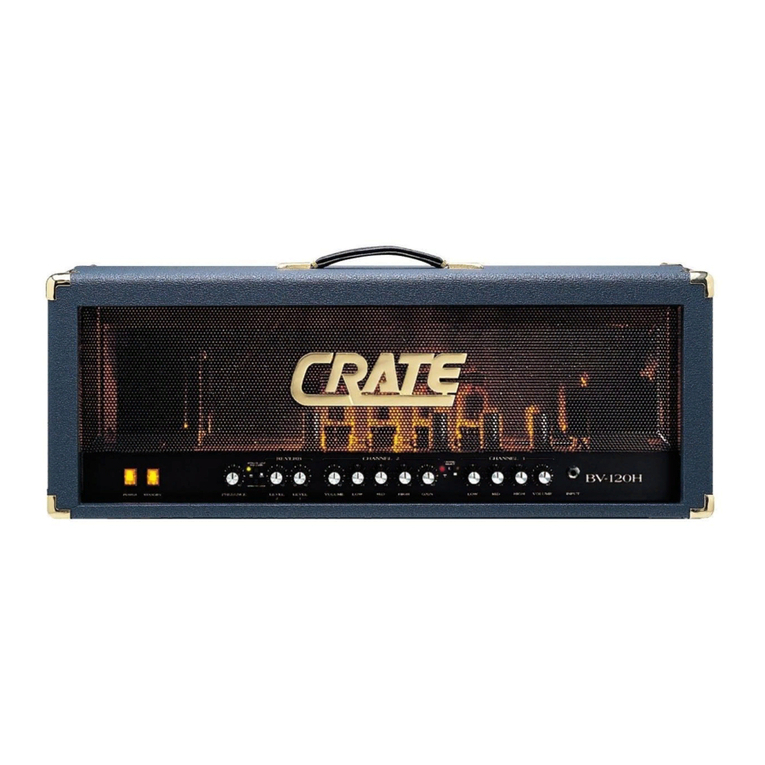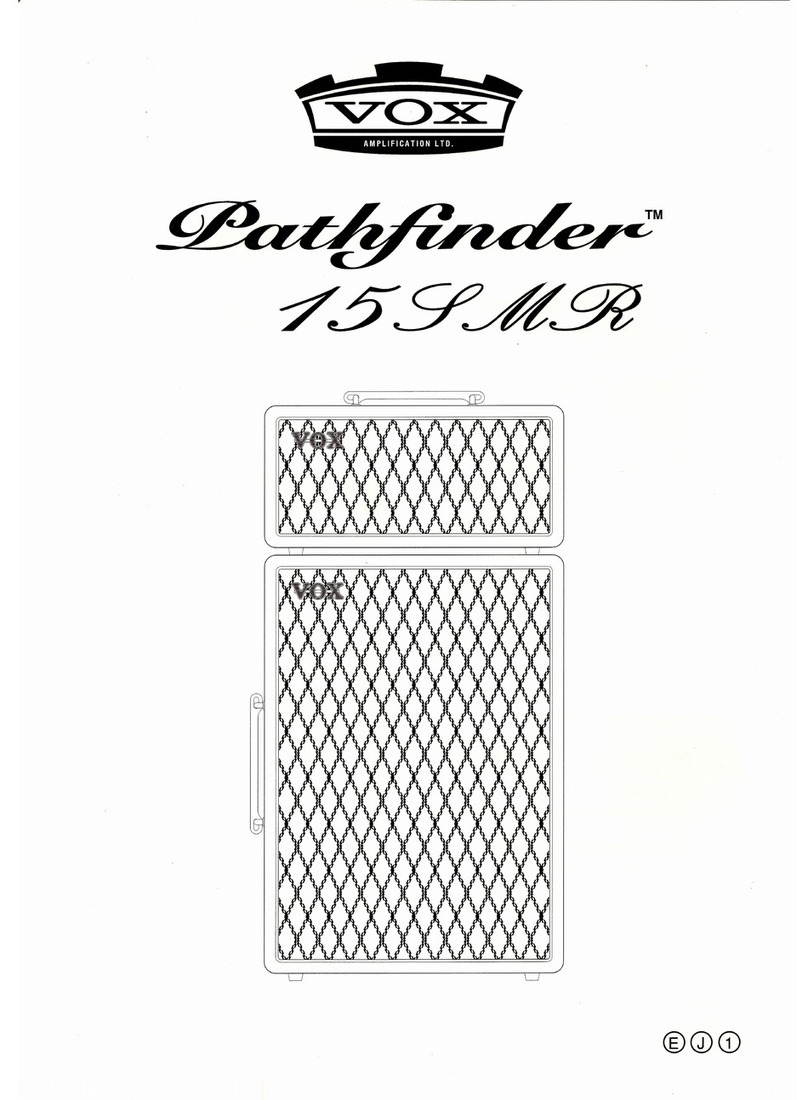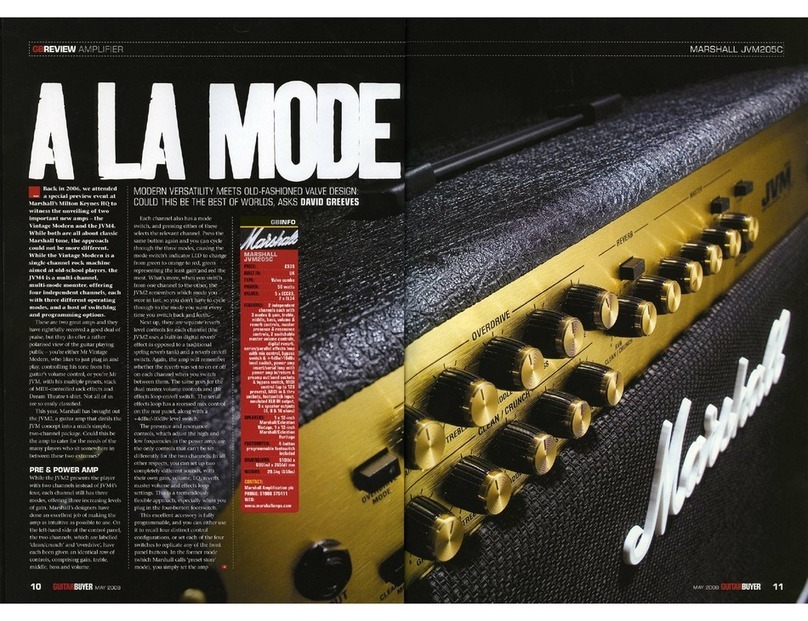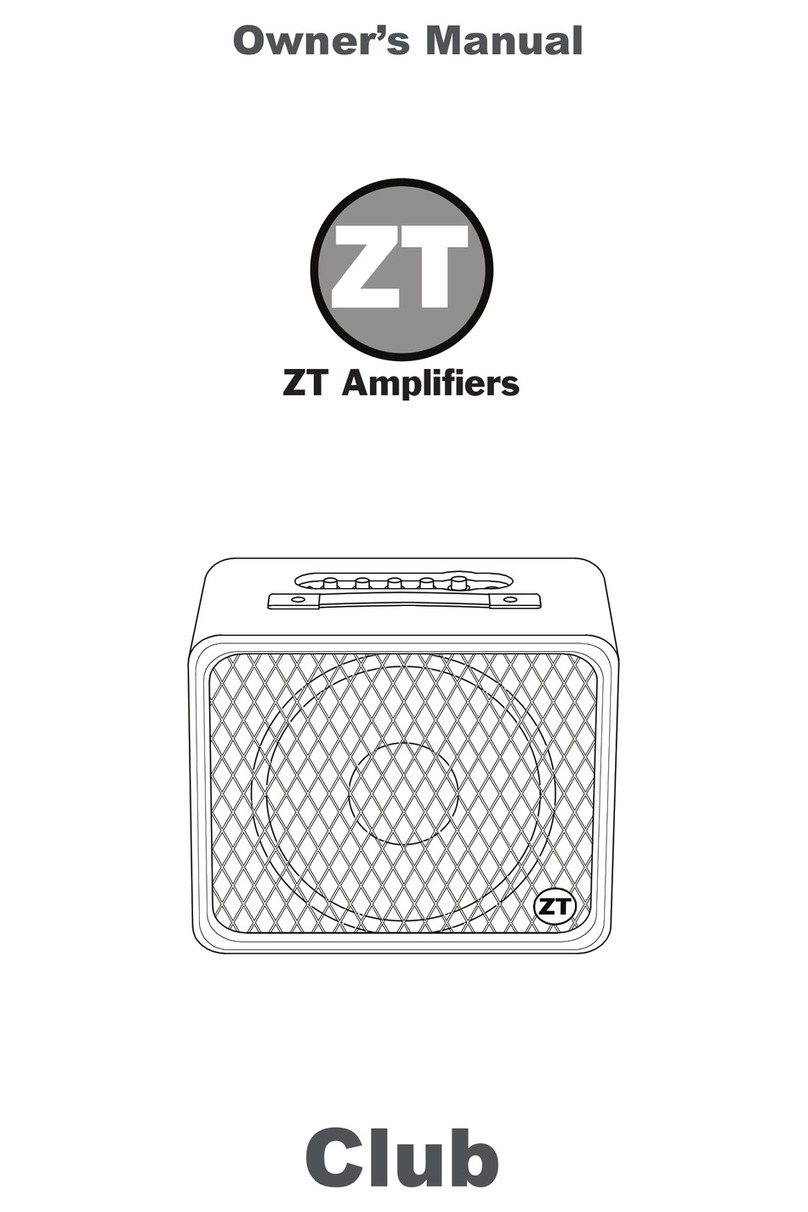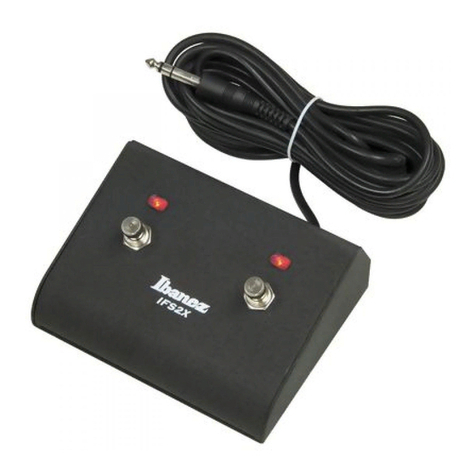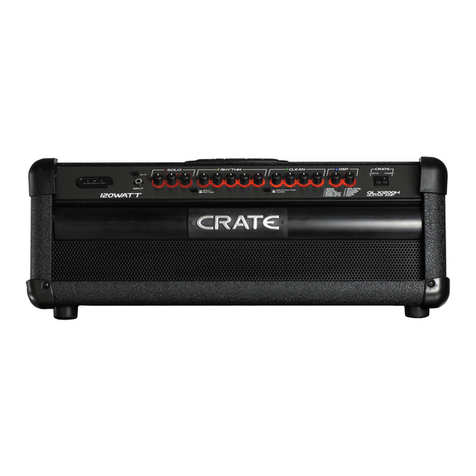Back in 2006, I was at the Dallas Vintage Guitar Show and my
band was scheduled to perform a few times. A friend said,
“Hey. You need an amp to play through, and I have a friend
who makes great amps.” He took me to the booth of a Texas
amp builder, Doug Sewell. I loved the way his amps sounded,
and after barely saying hello, Doug and I were inside rewiring
the amp I was going to play through. Since that day, Doug and I
have spent years rewiring and listening to every single possible
variation to finalize the circuits. Our goal was to have highly
usable and musical amplifiers.
I am not an amp collector. I am an amplifier user who keeps
the amps I am presently playing through. That said, after Doug
and I got several of the prototypes finalized, I sold some of
my old coveted live and studio amps because ours sounded
considerably beer. The next step was to take the prototypes
to musicians who are known for their amplifier tone as well as
their playing. What’s interesting is that when I spoke to these
artists about trying the amps, they all said the same thing.
“Sure I’ll use them, if I love them.”
In a real way, amplifiers are musical instruments. They are the
devices that “amplify” the sound of the player’s hands, the
guitar and possibly the pedal board. They must share many
qualities. They must work - they have to have a beautiful
balance of bass, midrange, and treble; the highs should be
sweet - not harsh; they should be easy to operate and be
highly musical. In addition, amps should clean up really well
when you turn your guitar down. The final quality that Doug
and I looked for are amps that sound good no maer where
the knobs are. It is a rare quality that we insisted on.
I hope this hand-crafted amplifier gives you years of
enjoyment, musical results, and pride in ownership. I
appreciate your confidence.
Using your PRS Amplifier
IMPORTANT: Before using your amplifier, refer to the IMPORTANT SAFETY INSTRUCTIONS insert
supplied with the product.
Powering Up:
1. Make sure your speaker cabinet is connected to the correct speaker output impedance jack with a
high quality speaker cable. Do not use guitar cords.
2. Make sure the power cord is connected to the correct grounded outlet.
3. Make sure there is at least 6 inches of clearance behind the amplifier to allow for proper cooling.
Never place the amplifier against a wall or other equipment, and keep it clear of other heat sources,
such as other amplifiers or stoves. Make sure there are no flammable items such as curtains,
behind the amp. Do not drape items over the amp that can prevent proper cooling. Do not set
drinks or other liquids on top of the amp that can spill into the amp.
4. To increase the life of the tubes, set the “Standby” switch to the STANDBY position before
powering on. Turn the POWER switch on and let the amplifier warm up for 2 minutes before seing
the standby switch to “ON.” If this is the first time you are turning on the amp, check to see if all of
the tubes are glowing.
5. Plug in the guitar cable, turn the volume knob down and turn the standby switch on. Wait a few
seconds for the bias to sele. Bring the volume up and play some tunes.
Input: 1/4” standard guitar cord.
Treble Gain: The circuitry is configured like a vintage two-channel amplifier that has been ‘bridged’
with a Y-cord. The treble gain acts like the volume of the brighter channel. It can be used like an
additional tone knob to adjust the overall tone in a brighter or darker fashion, relative to the bass
channel gain control.
Bass Gain: As noted above, this volume controls the internal bass channel that is linked to the treble
channel. Increase this channel’s volume relative to the treble gain control to adjust the overall tone of
the amp in a brighter or darker fashion.
Treble: The treble control is very sensitive in both clean and dirty seings. Like all of the control
knobs, there are no numbers to encourage you to set the amp with your ears.
Middle: Using less mids creates crisper, more “hollow” sounding tones. Clean seings using less mids
can sound very American, working well with single coil tones for clean blues and country. Adding
mids transforms the tone to a warm, faer jazz-approved tone. Distortion with more mids can sound
very 60s and 70s, less mids ventures into 80s metal tones.
Bass: The low end control allows you to tailor the amount of bass appropriate for the speakers and
cabinet you are playing through. Inherently bassy cabinets can sound very boomy with high bass
seings on the amp. Open back cabinets generally can accept higher bass seings without this.
Presence: An additional control to adjust the overall brightness and high-end gain of the amp.
Waage: This six position switch acts as a voltage divider in the phase inverter to incrementally
reduce the drive signal going to the power tubes. The last position disconnects the switch from
the circuitry, leaving the stock values unaltered. When running the amp wide-open, it is suggested
to select the second position (one degree of aenuation) for extended tube life. Do not adjust the
waage control while playing guitar though the amp at high volumes because of potential volume
spikes between switch positions.
Jewel Power Indicator: If the lamp is lit, the amp is on. This does not indicate the standby seing of
the amp. Note: An amplifier may be plugged in and “on”, but a malfunctioning or burnt-out indicator
will not show the amp is on. Check the power cord and Power Switch if the jewel light is not on. If
these are connected correctly, then check the main fuse. If the main fuse burns out, check for proper
speaker connections. If the fuses continue to blow, the amplifier may need servicing.
Fuse: Blown fuses may indicate that the amplifier needs servicing. Use only the type and rating
specified on the back of the amplifier. See the section on Service Notes for proper fuse servicing
and replacement.
Power Switch: This cuts o all power to the amplifier. No filament current or tube voltages are
supplied.
Standby Switch: When this switch is in STANDBY, the amplifier tubes are eectively turned o, but
are still being warmed by the filaments if the POWER is on. Keep this switch set to STANDBY when
powering on the amplifier for at least 2 minutes to allow the tubes to warm up. This also helps
extend the life of the tubes. When set to ON, the tubes are turned on and the amplifier can be
used. Always check this switch if the amp is ON but no sound is being heard.
Bias Jacks: Biasing and Tube Replacement should be performed only by a qualified technician.
Speaker Jacks: Get into the habit of checking these first. The jacks include a connection for 4, 8 and
16 ohm loads. There is an extension (EXT) jack with the 4 ohm and 8 ohm connection to connect
two 8 ohm loads if you wish. This scenario could most commonly be the use of an 8 ohm extension
speaker along with the internal speaker—connect each to the 4 ohm jacks since their combination
produces a 4 ohm load. Do not connect an 8 ohm load in the 8 ohm jack along with a 4 ohm or
16 ohm load in those jacks. This procedure halves the reflected impedance of each and will not
allow ideal operating conditions. If you are using more than one speaker, they must be the same
impedance. For example, use two 4-ohm speakers, or two 8-ohm speakers. Never use 2 dierent
speaker impedances - You should not mix and match. The maximum number of speakers you can
safely connect is 2. Always ensure that the speaker impedance matches the correct speaker jack
since this amp is designed to be played “wide open.” Mismatching impedances from a lower tap to
a higher speaker impedance stresses the amp more than going into a lower impedance mismatch
and can cause arcs on the tube sockets, failure of power tubes, or even failure of the output
transformer.
Confirm that the speaker cabinet you are using matches to the correct speaker jack on the back of
the amp. For the 4 OHM and 8 OHM speaker jacks, a second cabinet may be plugged into the “EXT”
(Extension) cabinet. Note: The total speaker impedance must be determined before connecting to
the speaker jacks.
25th Anniversary Amplifier Front Panel Controls
Rear Panel Controls
© 2010 PRS Guitars
All rights reserved.
“Paul Reed Smith,” “PRS,” the PRS logo, the PRS Paul Reed Smith logo, the Paul Reed Smith signature, the
bird inlays, the headstock bird, the PRS headstock shape, the PRS body shape, the PRS “scoop” design,
“Singlecut,” “Mira” and the “SE” are all registered trademarks of Paul Reed Smith Guitars “Custom
24,” “Modern Eagle,” “SE Custom,” “SC 245,” “SC 250,” “Starla,” “Tonare,” “Sewell,” “ Blue Sierra,” and
“Angelus” are all trademarks of Paul Reed Smith Guitars. The Birds, New Birds, are copyrighted by PRS
Guitars.
Type 3AG
Replace fuse only with
same type and rating.
250V
120V~60HZ
Input Power TO AVOIDDAMAGE, NEVER OPERATE WITHOUT PROPER SPEAKER LOAD
ADJUSTMENTS ONLY TOBE MADE BY QUALIFIED TECHNICIAN
CAUTION- RISK OF ELECTRIC SHOCK - DO NOT OPEN. No user serviceable parts inside
ATTENTION-RISQUE DE CHOC ÉLECTIQUE - NE PAS OUVRIR. No pièce réparable par l'utilisateur
WARNING- TO REDUCE THE RISK OF FIRE OR ELECTRIC SHOCK,
DO NOT EXPOSE THIS EQUIPMENT TO RAIN OR MOISTURE
AVIS - POUR RÉDUIRE LE RISQUE D'INCENDIE OU DE CHOC ÉLECTRIQUE,
NE PAS EXPOSER CET EQUIPEMENTA LA PLUIE OU L'HUMIDIT
FUSE
FUSE - 2A
250 W
BASS GAINTREBLE MIDDLE BASS
INPUT PRESENCE
TREGLE GAIN WATTAGE



